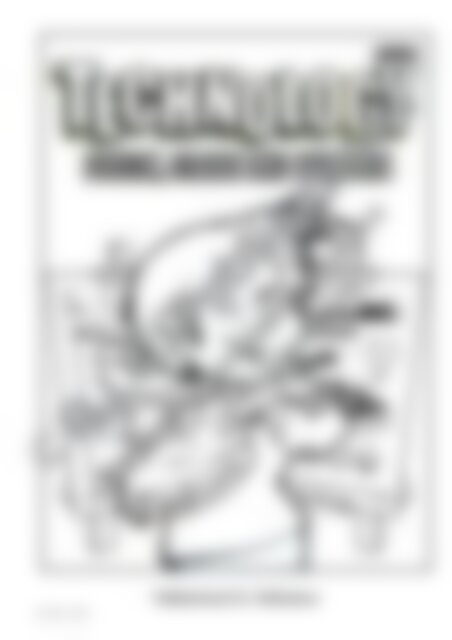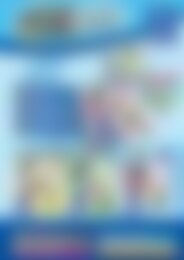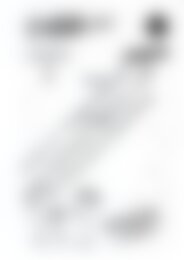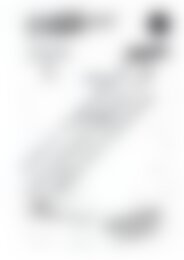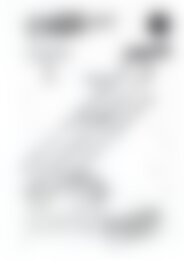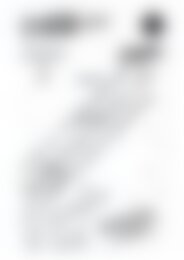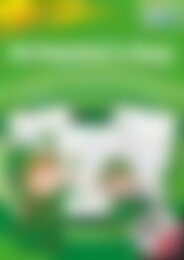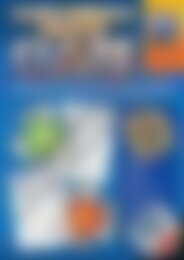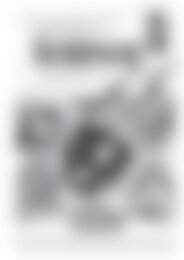RIC-0520 Technology - Design Create Evaluate - Ages 5-7
You also want an ePaper? Increase the reach of your titles
YUMPU automatically turns print PDFs into web optimized ePapers that Google loves.
<strong>RIC</strong>-<strong>0520</strong> 4.9/393<br />
Published by R.I.C. Publications
Foreword<br />
<strong>Technology</strong> is a blackline master for lower primary, full of tried and tested activities based on early learning<br />
outcomes for technology, which children will love. Each of the 15 models allows children to plan, then<br />
construct and evaluate.<br />
Each uses inexpensive, readily available materials, which children could collect and bring from home.<br />
The activities can be completed individually, in pairs or in small groups. The activities are ideally suited to<br />
encouraging collaborative learning skills.<br />
Activities can also be completed out of sequence (i.e. make the model first, and then reflect on the materials<br />
and function). This is particularly successful with pre-primary students.<br />
Contents<br />
Aeroplane ............................................................................................................................... 1–3<br />
Boat ........................................................................................................................................ 4–6<br />
Bridge ..................................................................................................................................... 7–9<br />
Fishing Game ....................................................................................................................... 10–12<br />
Greeting Card ...................................................................................................................... 13–15<br />
Healthy Sandwich ................................................................................................................. 16–18<br />
Jigsaw in a Box .................................................................................................................... 19–21<br />
Mobile ................................................................................................................................ 22–24<br />
Musical Instrument ................................................................................................................ 25–27<br />
Pet Home ............................................................................................................................. 28–30<br />
Picture Frame ....................................................................................................................... 31–33<br />
Popcorn Holder .................................................................................................................... 34–36<br />
Raft ..................................................................................................................................... 37–39<br />
Spectacles ........................................................................................................................... 40–42<br />
Wrapping Paper .................................................................................................................. 43–45<br />
R.I.C. Publications www.ricgroup.com.au <strong>Technology</strong> i
State Strand Level Outcome Statement<br />
National<br />
<strong>Technology</strong><br />
<strong>Design</strong>ing,<br />
Making and<br />
Appraising<br />
Outcome Links<br />
The activities in this book have been written to develop the following outcomes in technology.<br />
Investigating 1 1.1 Investigates the form, and identifies the uses of everyday products.<br />
2 2.1 Investigates and identifies the social uses and the effects of some products<br />
and processes.<br />
Devising 1 1.2 Generates ideas for own designs using trial and error, simple models and drawings.<br />
2 2.2 Generates designs that recognise some practical constraints using drawings,<br />
models and, where necessary, introducing some technical terms.<br />
Producing 1 1.3 Undertakes simple production processes with care and safety.<br />
2 2.3 Plans production processes and makes products and processes using resources safely.<br />
Evaluating 1 1.4 Describes feelings about own design ideas, products and processes.<br />
2 2.4 Compares own products and processes with original intentions.<br />
Materials<br />
Nature 1 1.7 Identifies common materials and some of their uses.<br />
2 2.7 Identifies some of the characteristics of common materials.<br />
Techniques 1 1.8 Uses equipment to manipulate and process common materials.<br />
2 2.8 Selects and uses equipment with increasing accuracy and control to manipulate<br />
and process materials.<br />
NSW Skills 1 & 1.2 & Students will be able to design and make products, systems and<br />
Science and 2 2.2 environments to meet specific needs.<br />
<strong>Technology</strong> 1 & 1.3 & Students will be able to select and use a range of technologies.<br />
2 2.3<br />
Values and 1 & 1.3 Values and attitudes towards science and technology<br />
Attitudes 2 2.3<br />
South <strong>Design</strong>ing 1 1.2 Demonstrates an initial variety of design behaviours.<br />
Australia 1.3 Uses a variety of ways of communicating design ideas.<br />
<strong>Design</strong> and 2 2.2 Applies a range of design skills.<br />
<strong>Technology</strong> 2.3 Uses a range of communication genres to express design ideas and planning.<br />
Making 1 1.4 Uses materials and equipment to make simple products, processes and systems.<br />
1.5 Explain the uses of basic materials and equipment.<br />
1.6 Recognises the importance of simple organisation and safety rules.<br />
2 2.4 Demonstrates effective use with a broad range of materials and equipment.<br />
2.5 Identifies the characteristics and uses of a range of materials and equipment.<br />
2.6 Identifies the reasons for managing resources and working safely.<br />
Victoria Materials and 1 1.1 Identify the characteristics and uses of some common materials.<br />
<strong>Technology</strong> Movement 1.2 Generate ideas for and process materials to make simple products.<br />
2 2.1 Describe the characteristics of common materials and relate the characteristics to<br />
possible uses.<br />
2.2 Develop simple products and describe the products in relation to the original intention.<br />
WA Materials<br />
<strong>Technology</strong> Nature 1 M1.1 Understands that materials may be used for different purposes.<br />
and 2 M2.1 Understands that when selecting materials their properties are considered.<br />
Enterprise<br />
Techniques 1 M1.2 Uses equipment to safely manipulate and process common materials.<br />
2 M2.2 Selects and uses equipment with increasing accuracy and control to safely<br />
manipulate and process materials.<br />
<strong>Technology</strong><br />
Process<br />
Investigating 1 TP1.1 Investigates the form and identifies the uses of everyday products.<br />
Devising TP1.2 Generates ideas for own designs, using trial and error, simple models and drawings.<br />
Producing TP1.3 Undertakes simple production processes with care and safety.<br />
Evaluating TP1.4 Describes feelings about own design ideas, products and processes.<br />
R.I.C. Publications www.ricgroup.com.au <strong>Technology</strong> ii<br />
ISBN 978-1-86311-644-2
Teachers Notes<br />
Each activity in this book takes up 3 pages, which could cover 3–5 lessons.<br />
Page 1 is for the teacher. It describes the task and gives<br />
suggestions for background and extension activities. An<br />
assessment key at two levels (average and advanced) is<br />
included.<br />
Page 2 describes the goal and materials needed. Space<br />
is provided for students to draw<br />
their design and draw and label their intended materials.<br />
All tasks presume basic classroom materials will be<br />
provided, such as scissors, glue, pencils, crayons, sticky<br />
tape, stapler, string and wool.<br />
Page 3 is a self-evaluation sheet. Children<br />
test if their model has met the design brief<br />
by completing simple sentences and<br />
evaluating how they feel about their work.<br />
Further Ideas<br />
Display Ideas—the children’s work can be displayed in<br />
many ways.<br />
1. Display as you would art activities.<br />
2. Collect for portfolios.<br />
3. Classroom wall mural.<br />
4. Photographs (digital camera).<br />
5. Oral language (show and tell, sharing circles, oral<br />
reports, assembly reports).<br />
6. Library display.<br />
7. Web pages and PowerPoint computer displays.<br />
Special Events—parent, grandparent or buddy sessions can<br />
be organised using these activities in a circuit format.<br />
R.I.C. Publications www.ricgroup.com.au <strong>Technology</strong> iii<br />
ISBN 978-1-86311-644-2
Task:<br />
Background:<br />
Extension Activity:<br />
Outcome:<br />
Aeroplane<br />
To design and make an aeroplane that will fly more than one metre using a meat<br />
tray and two pieces of paper.<br />
Discuss and look at stimulus pictures of a variety of aircraft.<br />
Use other materials of your choice to design an aeroplane that can fly more than<br />
two metres.<br />
Assessment Checklist<br />
Name:<br />
Key: achieved the outcome<br />
observed partial achievement of the outcome<br />
did not achieve the outcome<br />
Achieving<br />
Used everyday objects to make an aeroplane.<br />
<strong>Design</strong>ed a simple aeroplane.<br />
Used materials in a safe manner.<br />
Completed a self-evaluation sheet.<br />
Achieving at an advanced level<br />
Used his/her aeroplane design to make an aeroplane similar to that designed.<br />
Could identify ways to make his/her design better (different materials, size, weight, structure).<br />
Drew realistic designs using available materials.<br />
Task:<br />
Background:<br />
Extension Activity:<br />
Outcome:<br />
Aeroplane<br />
To design and make an aeroplane that will fly more than one metre using a meat<br />
tray and two pieces of paper.<br />
Discuss and look at stimulus pictures of a variety of aircraft.<br />
Use other materials of your choice to design an aeroplane that can fly more than<br />
two metres.<br />
Assessment Checklist<br />
Name:<br />
Key: achieved the outcome<br />
observed partial achievement of the outcome<br />
did not achieve the outcome<br />
Achieving<br />
Used everyday objects to make an aeroplane.<br />
<strong>Design</strong>ed a simple aeroplane.<br />
Used materials in a safe manner.<br />
Completed a self-evaluation sheet.<br />
Achieving at an advanced level<br />
Used his/her aeroplane design to make an aeroplane similar to that designed.<br />
Could identify ways to make his/her design better (different materials, size, weight, structure).<br />
Drew realistic designs using available materials.<br />
R.I.C. Publications www.ricgroup.com.au <strong>Technology</strong> 1<br />
ISBN 978-1-86311-644-2
Aeroplane<br />
To design and make an aeroplane.<br />
two pieces of paper; glue; sticky tape and<br />
one polystyrene meat tray.<br />
Your plane needs to be able to fly more than one metre.<br />
1. Draw your design.<br />
2. Draw and label the materials you will need to make your design.<br />
R.I.C. Publications www.ricgroup.com.au <strong>Technology</strong> 2<br />
ISBN 978-1-86311-644-2
Aeroplane<br />
1. Complete the sentences.<br />
(a) My aeroplane is made of pieces of paper.<br />
(b) My aeroplane is made of meat tray.<br />
(c) My aeroplane has wings.<br />
(d) I used to stick my aeroplane together.<br />
2. Circle the correct answer.<br />
(a)<br />
(b)<br />
My aeroplane is bigger than my hand.<br />
OR<br />
My aeroplane is smaller than my hand.<br />
My aeroplane can fly more than one metre.<br />
OR<br />
My aeroplane can not fly more than one metre.<br />
3. I could improve my aeroplane by<br />
.<br />
4. Colour the face that shows how you feel about your aeroplane.<br />
Do not like it Not sure OK Great<br />
R.I.C. Publications www.ricgroup.com.au <strong>Technology</strong> 3<br />
ISBN 978-1-86311-644-2
Task:<br />
Background:<br />
Extension Activity:<br />
Boat<br />
To design and make a boat with a sail which will float, using household materials.<br />
Observe objects that float or sink in a container of water.<br />
Discuss materials that float. Look at pictures of sailboats and study different designs.<br />
Make a boat that will float holding 10 or more washers.<br />
Outcome:<br />
Assessment Checklist<br />
Name:<br />
Key: achieved the outcome<br />
observed partial achievement of the outcome<br />
did not achieve the outcome<br />
Achieving<br />
Used appropriate household materials to construct the boat.<br />
<strong>Design</strong>ed a simple boat.<br />
Used tools and materials safely.<br />
Completed a self-evaluation sheet.<br />
Achieving at an advanced level<br />
Followed the design to construct the boat.<br />
Identified appropriate materials to use for the design.<br />
Identified ways to improve the construction of the boat.<br />
Task:<br />
Background:<br />
Extension Activity:<br />
Boat<br />
To design and make a boat with a sail which will float, using household materials.<br />
Observe objects that float or sink in a container of water.<br />
Discuss materials that float. Look at pictures of sailboats and study different designs.<br />
Make a boat that will float holding 10 or more washers.<br />
Outcome:<br />
Assessment Checklist<br />
Name:<br />
Key: achieved the outcome<br />
observed partial achievement of the outcome<br />
did not achieve the outcome<br />
Achieving<br />
Used appropriate household materials to construct the boat.<br />
<strong>Design</strong>ed a simple boat.<br />
Used tools and materials safely.<br />
Completed a self-evaluation sheet.<br />
Achieving at an advanced level<br />
Followed the design to construct the boat.<br />
Identified appropriate materials to use for the design.<br />
Identified ways to improve the construction of the boat.<br />
R.I.C. Publications www.ricgroup.com.au <strong>Technology</strong> 4<br />
ISBN 978-1-86311-644-2
Give your boat a name.<br />
1. Draw your design.<br />
Boat<br />
To design a boat with a sail that will float.<br />
pop sticks; meat trays; cardboard; paper; aluminium<br />
foil; plasticine TM ; milk cartons and drink containers.<br />
2. Draw and label the materials you will need to make your design.<br />
R.I.C. Publications www.ricgroup.com.au <strong>Technology</strong> 5<br />
ISBN 978-1-86311-644-2
Boat<br />
1. Complete the sentences.<br />
(a) My boat is made of .<br />
(b) My boat’s name is .<br />
2. Circle the correct answer.<br />
(a)<br />
(b)<br />
(c)<br />
My boat has a sail.<br />
OR<br />
My boat does not have a sail.<br />
My boat is taller than a pencil.<br />
OR<br />
My boat is shorter than a pencil.<br />
My boat floats.<br />
OR<br />
My boat does not float.<br />
3. I could improve my boat by<br />
.<br />
4. Colour the face that shows how you feel about your boat.<br />
Do not like it Not sure OK Great<br />
R.I.C. Publications www.ricgroup.com.au <strong>Technology</strong> 6<br />
ISBN 978-1-86311-644-2
Task:<br />
Background:<br />
Extension Activity:<br />
Outcome:<br />
Bridge<br />
To design and construct a bridge that is as long as a ruler and can hold a toy car.<br />
View various pictures of bridges. Discuss purposes, safety and types of bridges.<br />
<strong>Design</strong> and make a bridge that will span two desks 50 cm apart.<br />
Assessment Checklist<br />
Name:<br />
Key: achieved the outcome<br />
observed partial achievement of the outcome<br />
did not achieve the outcome<br />
Achieving<br />
Identified the uses of everyday products when making the bridge.<br />
<strong>Design</strong>ed a simple bridge.<br />
Constructed the bridge using tools and materials safely.<br />
Able to use appropriate materials to make the bridge.<br />
Completed a self-evaluation sheet.<br />
Achieving at an advanced level<br />
Identified the features to make the appropriate bridge.<br />
<strong>Design</strong>ed a bridge meeting the criteria.<br />
Safely used materials when constructing the bridge.<br />
Chose materials suitable for the components of the bridge.<br />
Task:<br />
Background:<br />
Extension Activity:<br />
Outcome:<br />
Bridge<br />
To design and construct a bridge that is as long as a ruler and can hold a toy car.<br />
View various pictures of bridges. Discuss purposes, safety and types of bridges.<br />
<strong>Design</strong> and make a bridge that will span two desks 50 cm apart.<br />
Assessment Checklist<br />
Name:<br />
Key: achieved the outcome<br />
observed partial achievement of the outcome<br />
did not achieve the outcome<br />
Achieving<br />
Identified the uses of everyday products when making the bridge.<br />
<strong>Design</strong>ed a simple bridge.<br />
Constructed the bridge using tools and materials safely.<br />
Able to use appropriate materials to make the bridge.<br />
Completed self-evaluation sheet.<br />
Achieving at an advanced level<br />
Identified the features to make the appropriate bridge.<br />
<strong>Design</strong>ed a bridge meeting the criteria.<br />
Safely used materials when constructing the bridge.<br />
Choose materials suitable for the components of the bridge.<br />
R.I.C. Publications www.ricgroup.com.au <strong>Technology</strong> 7<br />
ISBN 978-1-86311-644-2
Bridge<br />
1. Draw your design.<br />
To design and make a bridge that is as long as a ruler.<br />
It must be able to hold a toy car.<br />
Lego TM ; plasticine TM ; pop sticks; toilet rolls; string; glue;<br />
cardboard or other household items.<br />
2. Draw and label the materials you will need to make your design.<br />
R.I.C. Publications www.ricgroup.com.au <strong>Technology</strong> 8<br />
ISBN 978-1-86311-644-2
Bridge<br />
1. Complete the sentences.<br />
(a)<br />
My bridge is made of<br />
2. Circle the correct answer.<br />
(a)<br />
My bridge is as long as a ruler.<br />
OR<br />
My bridge is not as long as a ruler.<br />
(b)<br />
My bridge can hold a toy car.<br />
OR<br />
My bridge can not hold a toy car.<br />
3. I could improve my bridge by<br />
4. Colour the circle that shows how you feel about your bridge.<br />
Do not like it Not sure OK Great<br />
R.I.C. Publications www.ricgroup.com.au <strong>Technology</strong> 9<br />
ISBN 978-1-86311-644-2
Task:<br />
Background:<br />
Extension Activity:<br />
Outcome:<br />
Fishing Game<br />
To design and make a fishing game with a fishing rod and two fish.<br />
Discuss purpose and rules of different games. Experiment with magnets.<br />
<strong>Design</strong> another fishing game using this equipment that you can play with a friend.<br />
Assessment Checklist<br />
Name:<br />
Key: achieved the outcome<br />
observed partial achievement of the outcome<br />
did not achieve the outcome<br />
Achieving<br />
<strong>Design</strong>ed a simple fishing game.<br />
Made the fishing game using materials safely.<br />
Chose correct materials suited to the components of the fishing game.<br />
Completed a self-evaluation sheet.<br />
Achieving at an advanced level<br />
Used the design to make a fishing game similar to the design.<br />
Planned the materials and steps needed to safely make the fishing game from the design.<br />
Identified materials and rules to improve the fishing game.<br />
Constructive comments made on an evaluation sheet.<br />
Task:<br />
Background:<br />
Extension Activity:<br />
Outcome:<br />
Fishing Game<br />
To design and make a fishing game with a fishing rod and two fish.<br />
Discuss purpose and rules of different games. Experiment with magnets.<br />
<strong>Design</strong> another fishing game using this equipment that you can play with a friend.<br />
Assessment Checklist<br />
Name:<br />
Key: achieved the outcome<br />
observed partial achievement of the outcome<br />
did not achieve the outcome<br />
Achieving<br />
<strong>Design</strong>ed a simple fishing game.<br />
Made the fishing game using materials safely.<br />
Chose correct materials suited to the components of the fishing game.<br />
Completed a self-evaluation sheet.<br />
Achieving at an advanced level<br />
Used the design to make a fishing game similar to the design.<br />
Planned the materials and steps needed to safely make the fishing game from the design.<br />
Identified materials and rules to improve the fishing game.<br />
Constructive comments made on an evaluation sheet.<br />
R.I.C. Publications www.ricgroup.com.au <strong>Technology</strong> 10<br />
ISBN 978-1-86311-644-2
1. Draw your design.<br />
Fishing Game<br />
To design a fishing game with a fishing rod and two<br />
fish.<br />
The fishing rod must be able to catch the fish you have<br />
made. The fish must be able to go in water.<br />
a stick; wool; string; paperclips; magnets; ice-cream<br />
container lids; scissors and crayons.<br />
2. Draw and label the materials you will need to make your design.<br />
R.I.C. Publications www.ricgroup.com.au <strong>Technology</strong> 11<br />
ISBN 978-1-86311-644-2
1. Complete the sentences.<br />
Fishing Game<br />
(a)<br />
My fishing rod is made of<br />
.<br />
(b)<br />
My fish are made of<br />
2. Circle the correct answer.<br />
.<br />
(a)<br />
(b)<br />
(c)<br />
My fishing rod can pick up my fish.<br />
OR<br />
My fishing rod can not pick up my fish.<br />
My fish can go in water.<br />
OR<br />
My fish can not go in water.<br />
I like playing my fishing game.<br />
OR<br />
I do not like playing my fishing game.<br />
3. I could improve my fishing game by<br />
4. Colour the face that shows how you feel about your fishing game.<br />
.<br />
Do not like it Not sure OK Great<br />
R.I.C. Publications www.ricgroup.com.au <strong>Technology</strong> 12<br />
ISBN 978-1-86311-644-2
Task:<br />
Background:<br />
Extension Activity:<br />
Outcome:<br />
Greeting Card<br />
To design and make a pop-out card for someone special.<br />
View various cards with different purposes. Look at the pop-up or pop-out styles.<br />
Discuss why cards are given.<br />
<strong>Design</strong> another card that will give the person a surprise when he/she opens it.<br />
Assessment Checklist<br />
Name:<br />
Key: achieved the outcome<br />
observed partial achievement of the outcome<br />
did not achieve the outcome<br />
Achieving<br />
Identified the uses of everyday products when making the card.<br />
<strong>Design</strong>ed a simple card.<br />
Constructed the card using tools and materials safely.<br />
Able to use appropriate materials to make the card.<br />
Completed a self-evaluation sheet.<br />
Achieving at an advanced level<br />
Identified the features to make the appropriate card to convey the message.<br />
<strong>Design</strong>ed a card meeting the criteria.<br />
Safely used materials when constructing the card.<br />
Chose materials suitable for the components of the card.<br />
Task:<br />
Background:<br />
Extension Activity:<br />
Outcome:<br />
Greeting Card<br />
To design and make a pop-out card for someone special.<br />
View various cards with different purposes. Look at the pop-up or pop-out styles.<br />
Discuss why cards are given.<br />
<strong>Design</strong> another card that will give the person a surprise when he/she opens it.<br />
Assessment Checklist<br />
Name:<br />
Key: achieved the outcome<br />
observed partial achievement of the outcome<br />
did not achieve the outcome<br />
Achieving<br />
Identified the uses of everyday products when making the card.<br />
<strong>Design</strong>ed a simple card.<br />
Constructed the card using tools and materials safely.<br />
Able to use appropriate materials to make the card.<br />
Completed a self-evaluation sheet.<br />
Achieving at an advanced level<br />
Identified the features to make the appropriate card to convey the message.<br />
<strong>Design</strong>ed a card meeting the criteria.<br />
Safely used materials when constructing the card.<br />
Chose materials suitable for the components of the card.<br />
R.I.C. Publications www.ricgroup.com.au <strong>Technology</strong> 13<br />
ISBN 978-1-86311-644-2
1. Draw your design.<br />
Greeting Card<br />
To design and make a card for someone special.<br />
It must be a two-dimensional shape.<br />
It must have a pop-out picture or middle.<br />
one piece of A3 cardboard; magazines or<br />
photocopied pictures.<br />
2. Draw and label the materials you will need to make your design.<br />
R.I.C. Publications www.ricgroup.com.au <strong>Technology</strong> 14<br />
ISBN 978-1-86311-644-2
1. Complete the sentences.<br />
Greeting Card<br />
(a)<br />
My card is made for<br />
(b) My card is a shape.<br />
(C) My card is made of .<br />
2. Circle the correct answer.<br />
(a)<br />
My card is bigger than my pencil case.<br />
OR<br />
My card is smaller than my pencil case.<br />
(b)<br />
My card has a pop-out middle.<br />
OR<br />
My card does not have a pop-out middle.<br />
3. I could improve my card by<br />
4. Colour the face that shows how you feel about your greeting card.<br />
Do not like it Not sure OK Great<br />
R.I.C. Publications www.ricgroup.com.au <strong>Technology</strong> 15<br />
ISBN 978-1-86311-644-2
Task:<br />
Background:<br />
Extension Activity:<br />
Outcome:<br />
Healthy Sandwich<br />
To design and make a healthy sandwich.<br />
Healthy food discussions using pictures. Compare the benefits of healthy food with<br />
junk food.<br />
<strong>Design</strong> a healthy meal using the food pyramid.<br />
Assessment Checklist<br />
Name:<br />
Key: achieved the outcome<br />
observed partial achievement of the outcome<br />
did not achieve the outcome<br />
Achieving<br />
Identified the healthy foods suitable for making a sandwich.<br />
<strong>Design</strong>ed a simple healthy sandwich.<br />
Chose correct materials suited to the sandwich.<br />
Completed a self-evaluation sheet.<br />
Achieving at an advanced level<br />
Investigated decisions on who chooses foods that are eaten.<br />
Able to group foods according to their health qualities.<br />
<strong>Design</strong>ed the sandwich acknowledging the healthy elements.<br />
Task:<br />
Background:<br />
Extension Activity:<br />
Outcome:<br />
Healthy Sandwich<br />
To design and make a healthy sandwich.<br />
Healthy food discussions using pictures. Compare the benefits of healthy food with<br />
junk food.<br />
<strong>Design</strong> a healthy meal using the food pyramid.<br />
Assessment Checklist<br />
Name:<br />
Key: achieved the outcome<br />
observed partial achievement of the outcome<br />
did not achieve the outcome<br />
Achieving<br />
Identified the healthy foods suitable for making a sandwich.<br />
<strong>Design</strong>ed a simple healthy sandwich.<br />
Chose correct materials suited to the sandwich.<br />
Completed a self-evaluation sheet.<br />
Achieving at an advanced level<br />
Investigated decisions on who chooses foods that are eaten.<br />
Able to group foods according to their health qualities.<br />
<strong>Design</strong>ed the sandwich acknowledging the healthy elements.<br />
R.I.C. Publications www.ricgroup.com.au <strong>Technology</strong> 16<br />
ISBN 978-1-86311-644-2
Healthy Sandwich<br />
To design and make a healthy sandwich.<br />
two pieces of bread; three or more healthy fillings.<br />
1. Draw your design.<br />
2. Draw and label the materials you will need to make your design.<br />
R.I.C. Publications www.ricgroup.com.au <strong>Technology</strong> 17<br />
ISBN 978-1-86311-644-2
1. Complete the sentences.<br />
Healthy Sandwich<br />
(a) My sandwich is made with pieces of bread.<br />
(b)<br />
My sandwich fillings are<br />
2. Circle the correct answer.<br />
.<br />
(a)<br />
(b)<br />
My sandwich tastes great.<br />
OR<br />
My sandwich does not taste very nice.<br />
My sandwich is healthy.<br />
OR<br />
My sandwich is not healthy.<br />
3. I could improve my sandwich by<br />
4. Colour the face that shows how you feel about your sandwich.<br />
.<br />
Do not like it Not sure OK Great<br />
R.I.C. Publications www.ricgroup.com.au <strong>Technology</strong> 18<br />
ISBN 978-1-86311-644-2
Task:<br />
Background:<br />
Extension Activity:<br />
Outcome:<br />
Jigsaw in a Box<br />
To design and make a jigsaw puzzle from a magazine or poster picture and a box<br />
to put it in.<br />
Play with jigsaws and discuss their attributes. Examine a variety of boxes to see how<br />
they are made.<br />
<strong>Design</strong> and make a 20-piece jigsaw puzzle.<br />
Assessment Checklist<br />
Name:<br />
Key: achieved the outcome<br />
observed partial achievement of the outcome<br />
did not achieve the outcome<br />
Achieving<br />
<strong>Design</strong>ed a simple jigsaw puzzle and box.<br />
Made a jigsaw puzzle and box using materials safely.<br />
Able to choose correct materials suited to the components of the jigsaw puzzle and box.<br />
Achieving at an advanced level<br />
<strong>Design</strong> displays clear details.<br />
The puzzle matched the original design and outlined components.<br />
Puzzle pieces fit in the box.<br />
Puzzle pieces fit together accurately to make the original picture.<br />
Task:<br />
Background:<br />
Extension Activity:<br />
Outcome:<br />
Jigsaw in a Box<br />
To design and make a jigsaw puzzle from a magazine or poster picture and a box<br />
to put it in.<br />
Play with jigsaws and discuss their attributes. Examine a variety of boxes to see how<br />
they are made.<br />
<strong>Design</strong> and make a 20-piece jigsaw puzzle.<br />
Assessment Checklist<br />
Name:<br />
Key: achieved the outcome<br />
observed partial achievement of the outcome<br />
did not achieve the outcome<br />
Achieving<br />
<strong>Design</strong>ed a simple jigsaw puzzle and box.<br />
Made a jigsaw puzzle and box using materials safely.<br />
Able to choose correct materials suited to the components of the jigsaw puzzle and box.<br />
Achieving at an advanced level<br />
<strong>Design</strong> displays clear details.<br />
The puzzle matched the original design and outlined components.<br />
Puzzle pieces fit in the box.<br />
Puzzle pieces fit together accurately to make the original picture.<br />
R.I.C. Publications www.ricgroup.com.au <strong>Technology</strong> 19<br />
ISBN 978-1-86311-644-2
Jigsaw in a Box<br />
To make a 10-piece jigsaw puzzle and a box to keep<br />
it in.<br />
cardboard; glue; scissors; a magazine picture and<br />
posters.<br />
Give your jigsaw to a friend to see if he/she can do it!<br />
1. Draw your design.<br />
2. Draw and label the materials you will need to make your design.<br />
R.I.C. Publications www.ricgroup.com.au <strong>Technology</strong> 20<br />
ISBN 978-1-86311-644-2
1. Complete the sentences.<br />
Jigsaw in a Box<br />
(a) My jigsaw has pieces.<br />
(b)<br />
My jigsaw is a picture of<br />
(c) My box is made from .<br />
2. Circle the correct answer.<br />
.<br />
(a)<br />
My jigsaw puzzle fits in my box.<br />
OR<br />
My jigsaw puzzle does not fit in my box.<br />
(b)<br />
My friend could make my jigsaw puzzle picture.<br />
OR<br />
My friend could not make my jigsaw puzzle.<br />
3. I could improve my jigsaw by<br />
.<br />
4. Colour the face that shows how you feel about your jigsaw puzzle.<br />
Do not like it Not sure OK Great<br />
R.I.C. Publications www.ricgroup.com.au <strong>Technology</strong> 21<br />
ISBN 978-1-86311-644-2
Task:<br />
Background:<br />
Extension Activity:<br />
Outcome:<br />
Mobile<br />
To make a mobile with two levels.<br />
Discuss wind movements and how mobiles move. Look at bought mobiles, discuss<br />
the bright colours and the levels of the pictures/objects.<br />
With a friend, design and make a mobile that has three levels.<br />
Assessment Checklist<br />
Name:<br />
Key: achieved the outcome<br />
observed partial achievement of the outcome<br />
did not achieve the outcome<br />
Achieving<br />
<strong>Design</strong> is simple and planned for colour and object usage.<br />
Produced a simple mobile choosing correct materials.<br />
Used tools safely.<br />
Completed a self-evaluation sheet.<br />
Achieving at an advanced level<br />
<strong>Design</strong> shows detail of objects or pictures and the colour usage.<br />
Used materials accurately to create the mobile, recognising the constraints required in the design.<br />
Planned and used resources safely when making mobile.<br />
Compared the product to the proposed design to assess the desired effect.<br />
Task:<br />
Background:<br />
Extension Activity:<br />
Outcome:<br />
Mobile<br />
To make a mobile with two levels.<br />
Discuss wind movements and how mobiles move. Look at bought mobiles, discuss<br />
the bright colours and the levels of the pictures/objects.<br />
With a friend, design and make a mobile that has three levels.<br />
Assessment Checklist<br />
Name:<br />
Key: achieved the outcome<br />
observed partial achievement of the outcome<br />
did not achieve the outcome<br />
Achieving<br />
<strong>Design</strong> is simple and planned for colour and object usage.<br />
Produced a simple mobile choosing correct materials.<br />
Used tools safely.<br />
Completed a self-evaluation sheet.<br />
Achieving at an advanced level<br />
<strong>Design</strong> shows detail of objects or pictures and the colour usage.<br />
Used materials accurately to create the mobile, recognising the constraints required in the design.<br />
Planned and used resources safely when making mobile.<br />
Compared the product to the proposed design to assess the desired effect.<br />
R.I.C. Publications www.ricgroup.com.au <strong>Technology</strong> 22<br />
ISBN 978-1-86311-644-2
Mobile<br />
Make a mobile for your bedroom or family room.<br />
readily available household materials such as string; glue;<br />
scissors; cardboard; magazines and a clothes hanger.<br />
It must have two levels.<br />
The objects must not touch one another.<br />
It should be colourful and eye-catching.<br />
It must be able to hang from the ceiling.<br />
1. Draw your design.<br />
2. Draw and label the materials you will need to make your design.<br />
R.I.C. Publications www.ricgroup.com.au <strong>Technology</strong> 23<br />
ISBN 978-1-86311-644-2
1. Complete the sentences.<br />
Mobile<br />
(a) I made a mobile for my .<br />
(b)<br />
The materials I used were<br />
2. Circle the correct answer.<br />
(a)<br />
(b)<br />
(c)<br />
It is colourful.<br />
OR<br />
It is not colourful.<br />
The objects do not touch each other.<br />
OR<br />
The objects do touch each other.<br />
It can hang from the ceiling.<br />
OR<br />
It can not hang from the ceiling.<br />
.<br />
3. I could improve my mobile by<br />
4. Colour the face that shows how you feel about your mobile.<br />
.<br />
Do not like it Not sure OK Great<br />
R.I.C. Publications www.ricgroup.com.au <strong>Technology</strong> 24<br />
ISBN 978-1-86311-644-2
Task:<br />
Background:<br />
Extension Activity:<br />
Outcome:<br />
Musical Instrument<br />
To design and make a musical instrument that will make sound.<br />
Experiment with different everyday objects to produce sounds. Look at a variety of<br />
musical instruments, and how they produce sound.<br />
Using your instrument, join with two or three friends to make a band and play a<br />
song or some music to the class.<br />
Assessment Checklist<br />
Name:<br />
Key: achieved the outcome<br />
observed partial achievement of the outcome<br />
did not achieve the outcome<br />
Achieving<br />
Selected everyday objects to make a musical instrument.<br />
<strong>Design</strong>ed a simple musical instrument.<br />
Used scissors, glue and everyday objects in a safe manner.<br />
Completed a self-evaluation sheet.<br />
Achieving at an advanced level<br />
<strong>Design</strong>ed his/her musical instrument based on an instrument he/she has seen.<br />
Followed his/her design to make a musical instrument.<br />
Identified ways of improving the design.<br />
Task:<br />
Background:<br />
Extension Activity:<br />
Outcome:<br />
Musical Instrument<br />
To design and make a musical instrument that will make sound.<br />
Experiment with different everyday objects to produce sounds. Look at a variety of<br />
musical instruments, and how they produce sound.<br />
Using your instrument, join with two or three friends to make a band and play a<br />
song or some music to the class.<br />
Assessment Checklist<br />
Name:<br />
Key: achieved the outcome<br />
observed partial achievement of the outcome<br />
did not achieve the outcome<br />
Achieving<br />
Selected everyday objects to make a musical instrument.<br />
<strong>Design</strong>ed a simple musical instrument.<br />
Used scissors, glue and everyday objects in a safe manner.<br />
Completed a self-evaluation sheet.<br />
Achieving at an advanced level<br />
<strong>Design</strong>ed his/her musical instrument based on an instrument he/she has seen.<br />
Followed his/her design to make a musical instrument.<br />
Identified ways of improving the design.<br />
R.I.C. Publications www.ricgroup.com.au <strong>Technology</strong> 25<br />
ISBN 978-1-86311-644-2
Give your instrument a name.<br />
1. Draw your design.<br />
Musical Instrument<br />
To design and make a musical instrument that can<br />
make sound.<br />
readily available household materials such as tins;<br />
drink containers; beans; rice; rocks and sticks.<br />
2. Draw and label the materials you will need to make your design.<br />
R.I.C. Publications www.ricgroup.com.au <strong>Technology</strong> 26<br />
ISBN 978-1-86311-644-2
Musical Instrument<br />
1. Complete the sentences.<br />
(a)<br />
My musical instrument is made from<br />
.<br />
2. Circle the correct answer.<br />
(a)<br />
My musical instrument makes sound.<br />
OR<br />
My musical instrument does not make sound.<br />
(b)<br />
(c)<br />
(d)<br />
It makes high/low sounds.<br />
It makes a soft/loud noise.<br />
My musical instrument is bigger than my desk.<br />
OR<br />
My musical instrument is smaller than my desk.<br />
3. I could improve my musical instrument by<br />
.<br />
4. Colour the face that shows how you feel about your musical<br />
instrument.<br />
Do not like it Not sure OK Great<br />
R.I.C. Publications www.ricgroup.com.au <strong>Technology</strong> 27<br />
ISBN 978-1-86311-644-2
Task:<br />
Background:<br />
Extension Activity:<br />
Outcome:<br />
Pet Home<br />
To design and construct a home for a pet.<br />
Discuss pet homes and needs. Look at pictures to show various homes for different<br />
pets. Visit a pet shop.<br />
<strong>Design</strong> an enclosure for a wild animal of your choice.<br />
Assessment Checklist<br />
Name:<br />
Key: achieved the outcome<br />
observed partial achievement of the outcome<br />
did not achieve the outcome<br />
Achieving<br />
Selected everyday objects to make a pet home.<br />
<strong>Design</strong>ed a simple pet home.<br />
Understands that materials can be used for different purposes.<br />
Used equipment safely.<br />
Completed a self-evaluation sheet.<br />
Achieving at an advanced level<br />
Observed animals in a range of pet homes, identified the features needed to meet the<br />
animal’s needs.<br />
<strong>Design</strong>ed the appropriate home to suit the animal, using suitable materials.<br />
Followed his/her design when constructing the pet home.<br />
Identified ways of improving his/her design.<br />
Task:<br />
Background:<br />
Extension Activity:<br />
Outcome:<br />
Pet Home<br />
To design and construct a home for a pet.<br />
Discuss pet homes and needs. Look at pictures to show various homes for different<br />
pets. Visit a pet shop.<br />
<strong>Design</strong> an enclosure for a wild animal of your choice.<br />
Assessment Checklist<br />
Name:<br />
Key: achieved the outcome<br />
observed partial achievement of the outcome<br />
did not achieve the outcome<br />
Achieving<br />
Selected everyday objects to make a pet home.<br />
<strong>Design</strong>ed a simple pet home.<br />
Understands that materials can be used for different purposes.<br />
Used equipment safely.<br />
Completed a self-evaluation sheet.<br />
Achieving at an advanced level<br />
Observed animals in a range of pet homes, identified the features needed to meet the<br />
animal’s needs.<br />
<strong>Design</strong>ed the appropriate home to suit the animal, using suitable materials.<br />
Followed his/her design when constructing the pet home.<br />
Identified ways of improving his/her design.<br />
R.I.C. Publications www.ricgroup.com.au <strong>Technology</strong> 28<br />
ISBN 978-1-86311-644-2
Pet Home<br />
<strong>Design</strong> and make a home for a pet of your choice.<br />
readily available household materials such as boxes;<br />
material; drink containers; tins and lids.<br />
Your pet home must have space for your pet to be able to<br />
eat and drink. It must have room for the pet to move.<br />
Remember, you don’t want some pets to run/fly away!<br />
1. Draw your design.<br />
2. Draw and label the materials you will need to make your design.<br />
R.I.C. Publications www.ricgroup.com.au <strong>Technology</strong> 29<br />
ISBN 978-1-86311-644-2
Pet Home<br />
1. Complete the sentences.<br />
(a) My pet home is for a .<br />
(b)<br />
My pet home is made of<br />
2. Circle the correct answer.<br />
.<br />
(a)<br />
(b)<br />
(c)<br />
My pet home has room for the pet to move.<br />
OR<br />
My pet home does not have room for the pet to move.<br />
My pet home has a place for the pet to eat and drink.<br />
OR<br />
My pet home does not have a place for the pet to eat and drink.<br />
My pet home is bigger than my chair.<br />
OR<br />
My pet home is smaller than my chair.<br />
3. I could improve my pet home by<br />
4. Colour the face that shows how you feel about your pet home.<br />
.<br />
Do not like it Not sure OK Great<br />
R.I.C. Publications www.ricgroup.com.au <strong>Technology</strong> 30<br />
ISBN 978-1-86311-644-2
Task:<br />
Background:<br />
Extension Activity:<br />
Outcome:<br />
Picture Frame<br />
To design and make a picture frame which can stand on a desk and hold<br />
an A5-size piece of paper.<br />
Discuss and look at stimulus pictures of a variety of picture frames.<br />
Examine the ways the frames stand up.<br />
<strong>Design</strong> and make a hanging picture frame.<br />
Assessment Checklist<br />
Name:<br />
Key: achieved the outcome<br />
observed partial achievement of the outcome<br />
did not achieve the outcome<br />
Achieving<br />
Used everyday objects to make a picture frame.<br />
<strong>Design</strong>ed a simple picture frame.<br />
Used materials in a safe manner.<br />
Completed a self-evaluation sheet.<br />
Achieving at an advanced level<br />
Used their picture frame design to make a picture frame similar to their design.<br />
Could identify ways to make their design better (different materials, size, weight, structure).<br />
Drew realistic designs using materials that are available.<br />
Task:<br />
Background:<br />
Extension Activity:<br />
Outcome:<br />
Picture Frame<br />
To design and make a picture frame which can stand on a desk and hold<br />
an A5-size piece of paper.<br />
Discuss and look at stimulus pictures of a variety of picture frames.<br />
Examine the ways the frames stand up.<br />
<strong>Design</strong> and make a hanging picture frame.<br />
Assessment Checklist<br />
Name:<br />
Key: achieved the outcome<br />
observed partial achievement of the outcome<br />
did not achieve the outcome<br />
Achieving<br />
Used everyday objects to make a picture frame.<br />
<strong>Design</strong>ed a simple picture frame.<br />
Used materials in a safe manner.<br />
Completed a self-evaluation sheet.<br />
Achieving at an advanced level<br />
Used their picture frame design to make a picture frame similar to their design.<br />
Could identify ways to make their design better (different materials, size, weight, structure).<br />
Drew realistic designs using materials that are available.<br />
R.I.C. Publications www.ricgroup.com.au <strong>Technology</strong> 31<br />
ISBN 978-1-86311-644-2
Picture Frame<br />
To design and make a picture frame.<br />
two pieces of cardboard.<br />
The picture needs to stand on a desk.<br />
The picture frame must hold a picture which is half the size of this sheet<br />
of paper ( ).<br />
Decorate your picture frame.<br />
1. Draw your design.<br />
2. Draw and label the materials you will need to make your design.<br />
R.I.C. Publications www.ricgroup.com.au <strong>Technology</strong> 32<br />
ISBN 978-1-86311-644-2
1. Complete the sentences.<br />
Picture Frame<br />
(a)<br />
My picture frame is made of<br />
2. Circle the correct answer.<br />
(a)<br />
(b)<br />
(c)<br />
My picture fits into my picture frame.<br />
OR<br />
My picture does not fit into my picture frame.<br />
My picture frame can stand on a desk.<br />
OR<br />
My picture frame can not stand on a desk.<br />
My picture frame is colourful.<br />
OR<br />
My picture frame is not colourful.<br />
3. I could improve my picture frame by<br />
4. Colour the face that shows how you feel about your picture frame.<br />
Do not like it Not sure OK Great<br />
R.I.C. Publications www.ricgroup.com.au <strong>Technology</strong> 33<br />
ISBN 978-1-86311-644-2
Task:<br />
Background:<br />
Extension Activity:<br />
Outcome:<br />
Popcorn Holder<br />
<strong>Design</strong> and construct a popcorn holder.<br />
Discuss and view the holders used at the movies. Note their shape, size and colour.<br />
Using the same materials, make a holder that will hold more popcorn than<br />
your first design.<br />
Assessment Checklist<br />
Name:<br />
Key: achieved the outcome<br />
observed partial achievement of the outcome<br />
did not achieve the outcome<br />
Achieving<br />
<strong>Design</strong> is simple and planned for colour and object usage.<br />
Produced a simple popcorn holder choosing correct materials.<br />
Used tools safely.<br />
Completed a self-evaluation sheet.<br />
Achieving at an advanced level<br />
<strong>Design</strong> displays clear details.<br />
Able to use materials accurately to create the popcorn holder, recognising the constraints<br />
required in the design.<br />
Planned and used resources safely when making the popcorn holder.<br />
Compared the product to the proposed design to assess the desired effect.<br />
Task:<br />
Background:<br />
Extension Activity:<br />
Outcome:<br />
Popcorn Holder<br />
<strong>Design</strong> and construct a popcorn holder.<br />
Discuss and view the holders used at the movies. Note their shape, size and colour.<br />
Using the same materials, make a holder that will hold more popcorn than<br />
your first design.<br />
Assessment Checklist<br />
Name:<br />
Key: achieved the outcome<br />
observed partial achievement of the outcome<br />
did not achieve the outcome<br />
Achieving<br />
<strong>Design</strong> is simple and planned for colour and object usage.<br />
Produced a simple popcorn holder choosing correct materials.<br />
Used tools safely.<br />
Completed a self-evaluation sheet.<br />
Achieving at an advanced level<br />
<strong>Design</strong> displays clear details.<br />
Able to use materials accurately to create the popcorn holder, recognising the constraints<br />
required in the design.<br />
Planned and used resources safely when making the popcorn holder.<br />
Compared the product to the proposed design to assess the desired effect.<br />
R.I.C. Publications www.ricgroup.com.au <strong>Technology</strong> 34<br />
ISBN 978-1-86311-644-2
Popcorn Holder<br />
Make a popcorn holder to take to the movies. It can<br />
be any shape.<br />
a square piece of paper; crayons or pencils for<br />
decorating.<br />
It must have the word ‘popcorn’ on it.<br />
It must be decorated.<br />
Your hand should be able to fit inside to get the popcorn out.<br />
1. Draw your design.<br />
2. Draw and label the materials you will need to make your design.<br />
R.I.C. Publications www.ricgroup.com.au <strong>Technology</strong> 35<br />
ISBN 978-1-86311-644-2
1. Complete the sentences.<br />
Popcorn Holder<br />
(a)<br />
(b)<br />
My popcorn holder is made of<br />
My popcorn holder is decorated with<br />
.<br />
.<br />
2. Circle the correct answer.<br />
(a)<br />
(b)<br />
(c)<br />
(d)<br />
I like the decoration on my popcorn holder.<br />
OR<br />
I do not like the decoration on my popcorn holder.<br />
My hand can fit inside to get the popcorn out.<br />
OR<br />
My hand can not fit inside to get the popcorn out.<br />
There are no holes in my popcorn holder.<br />
OR<br />
There are some holes in my popcorn holder.<br />
My popcorn holder is bigger than a loaf of bread.<br />
OR<br />
My popcorn holder is smaller than a loaf of bread.<br />
3. I could improve my popcorn holder by<br />
4. Colour the face that shows how you feel about your popcorn holder.<br />
.<br />
Do not like it Not sure OK Great<br />
R.I.C. Publications www.ricgroup.com.au <strong>Technology</strong> 36<br />
ISBN 978-1-86311-644-2
Task:<br />
Background:<br />
Extension Activity:<br />
Outcome:<br />
Raft<br />
To design and make a model raft that can carry a small box of treasure.<br />
Drama activities, where children imagine they have been stranded on an island.<br />
Discuss and view various raft pictures, what rafts are made from and the purpose of rafts.<br />
<strong>Design</strong> another vessel that will float, using other materials.<br />
Assessment Checklist<br />
Name:<br />
Key: achieved the outcome<br />
observed partial achievement of the outcome<br />
did not achieve the outcome<br />
Achieving<br />
<strong>Design</strong>ed a simple raft.<br />
Made the raft using materials safely.<br />
Able to choose correct materials suited to the components of the raft.<br />
Completed a self-evaluation sheet.<br />
Achieving at an advanced level<br />
Used raft design to make a raft similar to the design.<br />
Able to plan the materials and steps needed to safely make the raft from the design.<br />
Identified materials and properties to improve the raft’s performance.<br />
Constructive comments made on evaluation sheet.<br />
Task:<br />
Background:<br />
Extension Activity:<br />
Outcome:<br />
Raft<br />
To design and make a model raft that can carry a small box of treasure.<br />
Drama activities, where children imagine they have been stranded on an island.<br />
Discuss and view various raft pictures, what rafts are made from and the purpose of rafts.<br />
<strong>Design</strong> another vessel that will float, using other materials.<br />
Assessment Checklist<br />
Name:<br />
Key: achieved the outcome<br />
observed partial achievement of the outcome<br />
did not achieve the outcome<br />
Achieving<br />
<strong>Design</strong>ed a simple raft.<br />
Made the raft using materials safely.<br />
Able to choose correct materials suited to the components of the raft.<br />
Completed a self-evaluation sheet.<br />
Achieving at an advanced level<br />
Used raft design to make a raft similar to the design.<br />
Able to plan the materials and steps needed to safely make the raft from the design.<br />
Identified materials and properties to improve the raft’s performance.<br />
Constructive comments made on evaluation sheet.<br />
R.I.C. Publications www.ricgroup.com.au <strong>Technology</strong> 37<br />
ISBN 978-1-86311-644-2
1. Draw your design.<br />
Raft<br />
To design a model raft with a sail. It should be able to<br />
carry a small box (The ‘treasure’ can be a matchbox<br />
containing a small rock; wishing stones; marbles or<br />
similar.) without sinking.<br />
20 popsticks; 10 corks and one sheet of paper.<br />
2. Draw and label the materials you will need to make your design.<br />
R.I.C. Publications www.ricgroup.com.au <strong>Technology</strong> 38<br />
ISBN 978-1-86311-644-2
Raft<br />
1. Complete the sentences.<br />
(a) My raft is made with popsticks.<br />
(b) My raft is made with corks.<br />
(c) There is a sail on my raft.<br />
2. Circle the correct answer.<br />
(a)<br />
(b)<br />
My raft can float on its own.<br />
OR<br />
My raft can not float on its own.<br />
My raft can carry the treasure.<br />
OR<br />
My raft can not carry the treasure.<br />
3. I could improve my raft by<br />
.<br />
4. Colour the face that shows how you feel about your raft.<br />
Do not like it Not sure OK Great<br />
R.I.C. Publications www.ricgroup.com.au <strong>Technology</strong> 39<br />
ISBN 978-1-86311-644-2
Task:<br />
Background:<br />
Extension Activity:<br />
Outcome:<br />
Spectacles<br />
To design and make a pair of spectacles that you can see through.<br />
Discuss the purpose of spectacles. Look at different types of glasses and people’s<br />
choices of colour and style—show pictures of people wearing glasses for different<br />
situations and for different reasons, e.g. safety.<br />
Use other materials to make a monocle that you can wear.<br />
Assessment Checklist<br />
Name:<br />
Key: achieved the outcome<br />
observed partial achievement of the outcome<br />
did not achieve the outcome<br />
Achieving<br />
Able to select materials to make spectacles.<br />
Made a simple design to follow.<br />
Safely used tools when making spectacles.<br />
Completed a self-evaluation sheet.<br />
Achieving at an advanced level<br />
Able to consider the properties of materials suitable for constructing the spectacles.<br />
<strong>Design</strong> a pair of glasses considering the suitability of materials.<br />
Selects and uses equipment accurately and safely.<br />
Able to compare own product with design and process.<br />
Task:<br />
Background:<br />
Extension Activity:<br />
Outcome:<br />
Spectacles<br />
To design and make a pair of spectacles that you can see through.<br />
Discuss the purpose of spectacles. Look at different types of glasses and people’s<br />
choices of colour and style—show pictures of people wearing glasses for different<br />
situations and for different reasons, e.g. safety.<br />
Use other materials to make a monocle that you can wear.<br />
Assessment Checklist<br />
Name:<br />
Key: achieved the outcome<br />
observed partial achievement of the outcome<br />
did not achieve the outcome<br />
Achieving<br />
Able to select materials to make spectacles.<br />
Made a simple design to follow.<br />
Safely used tools when making spectacles.<br />
Completed a self-evaluation sheet.<br />
Achieving at an advanced level<br />
Able to consider the properties of materials suitable for constructing the spectacles.<br />
<strong>Design</strong> a pair of glasses considering the suitability of materials.<br />
Selects and uses equipment accurately and safely.<br />
Able to compare own product with design and process.<br />
R.I.C. Publications www.ricgroup.com.au <strong>Technology</strong> 40<br />
ISBN 978-1-86311-644-2
Spectacles<br />
To design and make a pair of spectacles that you can<br />
see through. They should fit you without falling off.<br />
One piece of cardboard; two different brightly-coloured<br />
pieces of paper and a small amount of aluminium foil.<br />
Your spectacles need to be colourful.<br />
1. Draw your design.<br />
2. Draw and label the materials you will need to make your design.<br />
R.I.C. Publications www.ricgroup.com.au <strong>Technology</strong> 41<br />
ISBN 978-1-86311-644-2
1. Complete the sentences.<br />
Spectacles<br />
(a)<br />
My spectacles are made of<br />
.<br />
(b) My spectacles are a/an shape.<br />
2. Circle the correct answer.<br />
(a)<br />
(b)<br />
(c)<br />
I can see through my spectacles.<br />
OR<br />
I can not see through my spectacles.<br />
I like the decoration on my spectacles.<br />
OR<br />
I do not like the decoration on my spectacles.<br />
My spectacles do not fall off my face.<br />
OR<br />
My spectacles fall off my face.<br />
3. I could improve my spectacles by<br />
.<br />
4. Colour the face that shows how you feel about your spectacles.<br />
Do not like it Not sure OK Great<br />
R.I.C. Publications www.ricgroup.com.au <strong>Technology</strong> 42<br />
ISBN 978-1-86311-644-2
Wrapping Paper<br />
Task:<br />
Background:<br />
Extension Activity:<br />
Outcome:<br />
To design and make a sheet of wrapping paper.<br />
View various wrapping paper designs. Discuss the purpose of wrapping paper.<br />
<strong>Design</strong> and make a gift box or bag for a gift.<br />
Assessment Checklist<br />
Name:<br />
Key: achieved the outcome<br />
observed partial achievement of the outcome<br />
did not achieve the outcome<br />
Achieving<br />
Able to make different patterns using various materials.<br />
<strong>Design</strong>ed a simple pattern for the wrapping paper.<br />
Completed a self-evaluation sheet.<br />
Achieving at an advanced level<br />
Able to use various patterns to create a range of designs.<br />
Used the design to construct the wrapping paper.<br />
Constructive comments made on evaluation sheet.<br />
Identified ways of improving the design.<br />
Wrapping Paper<br />
Task:<br />
Background:<br />
Extension Activity:<br />
Outcome:<br />
To design and make a sheet of wrapping paper.<br />
View various wrapping paper designs. Discuss the purpose of wrapping paper.<br />
<strong>Design</strong> and make a gift box or bag for a gift.<br />
Assessment Checklist<br />
Name:<br />
Key: achieved the outcome<br />
observed partial achievement of the outcome<br />
did not achieve the outcome<br />
Achieving<br />
Able to make different patterns using various materials.<br />
<strong>Design</strong>ed a simple pattern for the wrapping paper.<br />
Completed a self-evaluation sheet.<br />
Achieving at an advanced level<br />
Able to use various patterns to create a range of designs.<br />
Used the design to construct the wrapping paper.<br />
Constructive comments made on evaluation sheet.<br />
Identified ways of improving the design.<br />
R.I.C. Publications www.ricgroup.com.au <strong>Technology</strong> 43<br />
ISBN 978-1-86311-644-2
1. Draw your design.<br />
Wrapping Paper<br />
To make a piece of wrapping paper (about twice as<br />
big as this sheet of paper).<br />
It should be able to be used to wrap a gift.<br />
paint; crayons; sponges; leaves; various objects to<br />
print or rub; magazines; newspapers and paper.<br />
2. Draw and label the materials you will need to make your design.<br />
R.I.C. Publications www.ricgroup.com.au <strong>Technology</strong> 44<br />
ISBN 978-1-86311-644-2
1. Complete the sentences.<br />
Wrapping Paper<br />
(a)<br />
My wrapping paper is made with<br />
.<br />
(b)<br />
I am going to use my wrapping paper to wrap a gift for<br />
.<br />
(c)<br />
My wrapping paper is (colours)<br />
.<br />
2. Circle the correct answer.<br />
(a)<br />
(b)<br />
I could wrap up a gift with my wrapping paper.<br />
OR<br />
I could not wrap up a gift with my wrapping paper.<br />
My wrapping paper has a pattern.<br />
OR<br />
My wrapping paper does not have a pattern.<br />
3. I could improve my wrapping paper by<br />
4. Colour the face that shows how you feel about your wrapping paper.<br />
.<br />
Do not like it Not sure OK Great<br />
R.I.C. Publications www.ricgroup.com.au <strong>Technology</strong> 45<br />
ISBN 978-1-86311-644-2


